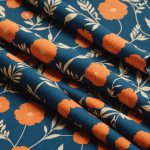Overview of Sustainable Fabrics
Sustainable fabrics are at the forefront of sustainable fashion, underscoring the move towards eco-friendly practices within the industry. These materials play a crucial role in reducing the environmental impact of fashion, often made with processes that conserve energy, water, and reduce pollution.
Current trends in sustainable fashion highlight a shift towards adopting eco-friendly materials. Such materials are not only crafted to be aesthetically pleasing but also aim to foster a healthier planet. Designers and brands are increasingly incorporating sustainable textiles into their collections, seeking solutions that resonate ethically and environmentally.
Also to see : The ultimate handbook for selecting the perfect premium british wool sweater
The environmental benefits of utilizing sustainable materials are significant. They minimize chemical use, reduce waste through biodegradability or recycling, and contribute to a carbon-neutral footprint. This approach not only aligns with growing consumer awareness but also complies with stricter international regulations on environmental conservation.
By integrating such materials, the fashion industry is striving to adapt to modern consumer expectations, where demand for transparency and responsibility is paramount. Brands that embrace these principles position themselves as leaders in a rapidly changing market landscape. Sustainable fashion is not just a trend; it is the future.
Also to read : Unlock amazing savings on stylish footwear at our shoe store!
Popular Sustainable Fabrics in 2023
Sustainable textiles are making waves in the fashion industry, with trendy fabrics like organic cotton, Tencel (Lyocell), and recycled polyester leading the way for a sustainable future.
Organic Cotton
Boasting popularity for its reduced environmental impact, organic cotton is free from synthetic pesticides and fertilizers. Its soft texture and breathability make it a favourite among designers seeking sustainable textiles that do not compromise on comfort. The cultivation promotes healthier ecosystems and biodiversity.
Tencel (Lyocell)
Derived from renewable wood sources, Tencel is an eco-friendly fabric celebrated for its versatility and comfort. Utilizing a closed-loop production process, it effectively minimizes waste and water usage, contributing positively to sustainability efforts. This makes it a preferred choice for designers like Stella McCartney, who value trendy fabrics that support sustainable practices.
Recycled Polyester
Recycled polyester is crafted from post-consumer waste, such as plastic bottles. This innovative approach not only diverts waste from landfills but also reduces the demand for virgin polyester production. Notable UK designers are embracing this sustainable textile for its durability and reduced carbon footprint, aligning with their ethos of responsible fashion choices.
Innovations in Sustainable Fabric Technologies
The rapid advancement of fabric technology introduces exciting pathways for more sustainable fashion. Modern eco-innovation has birthed materials such as Piñatex, derived from pineapple leaves, which offers a leather alternative that is both durable and biodegradable. Similarly, mushroom leather is gaining traction, developed from mycelium, the root structure of fungi. Not only are these materials less resource-intensive, but they also boast qualities aligned with sustainable solutions.
These technological innovations greatly contribute to reducing the environmental footprint of fashion. The creation of fabrics like Piñatex involves fewer water resources compared to traditional leather. This reduction is significant considering the vast amount of water used globally in textile production. Additionally, mushroom leather requires limited agricultural input, offering an eco-friendly alternative to animal-derived leathers.
By embracing these advances, the fashion industry not only addresses ecological concerns but also meets current consumer demands for responsible and innovative products. As technology continues to evolve, the potential for groundbreaking materials grows, promising a future where style is synonymous with sustainability. This shift in production practices signifies a brighter, more sustainable outlook for fashion’s impact on the planet.
UK Designers Championing Sustainability
In the sustainable fashion landscape, UK designers have emerged as torchbearers for ethical design and eco-friendly materials. Their emphasis on ethical practices has helped redefine industry standards and hold influential sway over consumer behaviour.
Designer Spotlight: Stella McCartney
Stella McCartney has cemented herself as a sustainable fashion leader, renowned for her commitment to using organic cotton and Tencel. By avoiding animal products, McCartney employs innovative trendy fabrics like recycled polyester, combining luxury with conscience. Her design philosophy prioritises environmental integrity, influencing both consumer expectations and global industry practices.
Designer Spotlight: Roksanda Ilincic
Roksanda Ilincic merges high-fashion aesthetics with sustainable textiles. Her collections often feature eco-friendly materials, using elevated craftsmanship to highlight fabric longevity. Ilincic’s work champions sustainable design without compromising style, pushing the narrative that fashion can be both conscientious and cutting-edge.
Emerging Designers
Emerging talent in the UK is amplifying sustainable fashion trends with imaginative approaches and bold textile choices. By experimenting with innovative trendy fabrics, these designers fuel optimism for a sustainable future. Their dedication to ethical design fosters an environment where informed, responsible consumerism thrives, transforming aspirations into industry norms.
Sourcing and Supply Chain Transparency
Transparency in the fashion industry’s supply chain is becoming crucial. Ethical sourcing proves essential not only for eco-friendly materials but also to build consumer trust. Responsible sourcing involves ensuring sustainable fabric technologies are adopted, from production to delivery. Some forward-thinking brands are setting a benchmark by pioneering transparent practices.
Brands leading the way in ethical sourcing include Patagonia and Everlane, which openly share the origin and treatment of materials used. They also disclose factory conditions, labour practices, and environmental impact metrics, setting industry standards.
Transparency leads to accountability, revelation of hidden costs, and potential challenges within the supply chain, effectively encouraging more sustainable practices. By enhancing supply chain management, companies can address consumer demand for responsible fashion. This boost in consumer confidence often transforms into brand loyalty, reinforcing the importance of these ethical practices.
The shift to transparent supply chains complements the industry’s overall move towards sustainable textiles. As consumers grow increasingly aware, brands are encouraged to maintain authenticity and accountability, positioning themselves as leaders who value environmental and ethical responsibilities.
The Future of Sustainable Fabrics
In 2023, the future of sustainable fabrics is poised to transform the fashion landscape. Advancements are directed towards crafting eco-friendly materials that not only meet current trends but also forecast future consumer preferences. With increased awareness in sustainable practices, industries are innovating with sustainable fashion to cater to evolving market demands.
Anticipated Trends in Sustainable Fabrics
Future trends point towards enhanced biodegradability and circularity in materials. The emergence of new technologies promises to provide eco-friendly materials that blend functionality with reduced environmental impact. These developments offer an insight into how fabric technology will evolve to accommodate industry changes.
Consumer Expectations and Preferences
Modern consumers advocate for trendy fabrics that are environmentally conscious, influencing brands to adapt and embrace transparency. As sustainability becomes integral, there is a growing demand for complete lifecycle assessments, ensuring fabrics sustain both ethical sourcing and supply chain management.
Potential Challenges and Opportunities
Despite promising advancements, sustainable fashion faces challenges like high costs and scalability issues. Nonetheless, these hurdles present opportunities for innovation and collaboration among industry players. The effort to balance cost with sustainability is essential in making eco-friendly materials accessible to a broader audience.
Visual Inspiration from Top Designers
In recent years, top designers have ingeniously incorporated sustainable fabrics into their collections, reshaping our perception of modern fashion. This visual transformation emphasizes style without compromising on environmental ethics. Renowned designers integrate eco-friendly materials, offering consumers inspiring fashion inspiration while reinforcing responsible practices.
Stella McCartney, an influential force in sustainable fashion, uses organic cotton and Tencel in striking ways, demonstrating luxury interwoven with conscience. Her designs serve as a blueprint for others looking to embrace style trends that respect our planet. Similarly, innovative brands showcase how trendy fabrics like recycled polyester are revolutionising mainstream fashion.
To truly captivate sustainable fashion enthusiasts, visuals play a critical role. They illustrate the vibrant textures and dynamic colors achievable with sustainable textiles. By presenting enticing fabric visuals, designers not only celebrate their art but also encourage a broader audience to delve into this stylishly responsible trend.
Explore these transformative style trends and discover how to integrate them into your wardrobe. The fusion of fashion inspiration with conscientious choices suggests a thrilling fashion evolution powered by both creativity and sustainability.











